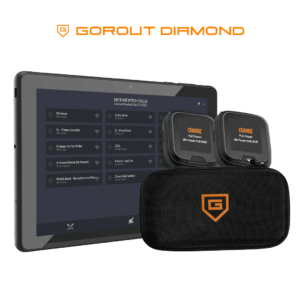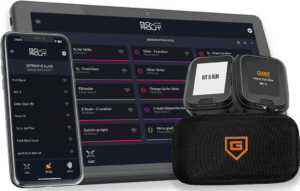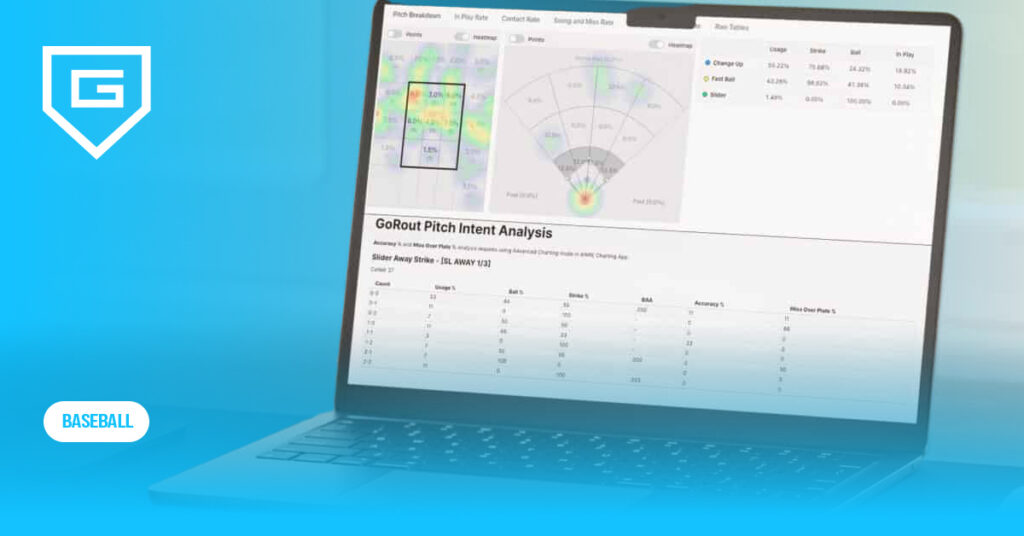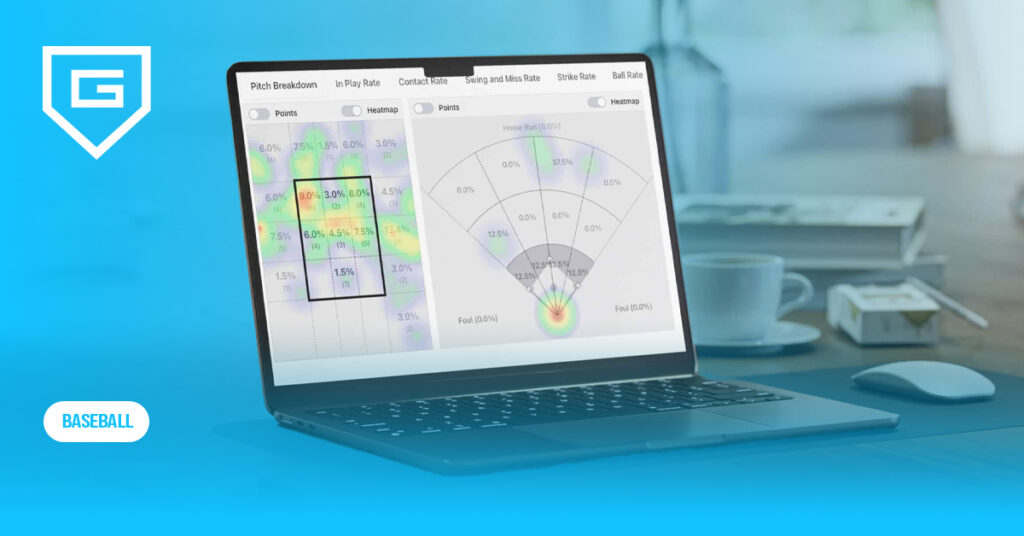Top Youth Baseball Drills to Challenge and Inspire Young Players
Reading Time: 10 minutes
Reading Time: 10 minutes
Coaches know that youth baseball drills are more than just practice—they’re the key for building players’ skills and their love for the game.
However, traditional methods often fall short in an age where young athletes want dynamic, interactive learning.
Advanced baseball pitch-calling systems like GoRout Diamond upgrade coaching by transforming complex baseball signs into visual, easy-to-follow cues and turning ordinary drills into exciting challenges kids want to master.
In this article, we’ll break down the basics of effective youth baseball drills while revealing how GoRout Diamond can sharpen your team’s execution—turning disjointed practices into cohesive, game-ready performances.
The Foundations of Effective Youth Baseball Drills

Young players need baseball drills to be fun and interesting, supported by a strong coach-to-player communication system. Coaches should prioritize activities that provide value while keeping kids attentive and focused.
Drills must balance physical and mental challenges to engage players. Framing them as games boosts enjoyment and accelerates skill development—whether improving throwing mechanics, base running, catching, or hitting—across all age groups.
For younger children, focus on age-appropriate challenges: Creative, simple activities teach basic hitting, throwing, and catching while fostering positivity. By age nine, players are ready to build on these fundamentals. Older kids prefer complex drills that boost teamwork, pitching, and fielding.
Modify traditional drills by adjusting speed, distance, or complexity to match skill levels. Small tweaks keep kids engaged and make practice both fun and impactful.
Key Youth Baseball Drills for Hitting Skills

Baseball hitting drills help kids build power and technique.
Tee time variations
A batting tee drill teaches players the core skills that apply to every part of hitting. Use multiple tees to cover different zones. Or, you can use one tee and adjust the height or move it to either side of the plate to practice hitting inside and outside pitches.
Young players should concentrate on three key concepts: having strong bat control, standing with their feet shoulder-width apart, and keeping their eyes on the ball as they swing.
Target hitting challenges
Mark specific zones for players to aim at and set up a scoring system to encourage friendly competition. They’ll focus on the game, cheer for their teammates, and improve their aim through fun rivalries.
Situational hitting games
Kids can get better at making decisions by practicing real-game situations—like figuring out how to move runners or score runs depending on where they hit the ball.
Hitting under pressure can feel overwhelming for kids, but simulating high-stakes scenarios (e.g., final inning, tie game) helps them stay calm and confident in the batter’s box, no matter the situation.
Try team competitions. Host a home run derby or challenge players to rack up consecutive line drives. It builds confidence, celebrates progress, and keeps kids excited about improving.
Make sure players always focus on fundamentals and proper swing techniques, even in power competitions.
Youth Baseball Fielding Drills That Build Confidence
Baseball fielding drills help teams hone their infield skills, outfield abilities, and glove work during practices to play their best.
Rapid-fire infield work
Infielders use every fielding drill to develop soft hands and learn how to field ground balls. Coaches add multiple ball-handling drills to their practice plan so infielders can get the feel of ground balls, double plays, and backhand plays.
Players practice verbal calls and non-verbal communication through exercises to help read their teammates. This helps the defense stay connected throughout games – especially in high-pressure or unpredictable situations.
When kids are young, they practice every infield position. Once they get older, coaches can add position-specific techniques for first basemen, middle infielders, third-basemen, catchers, and pitchers.
Outfield tracking games
Outfielders need to know how to track fly balls, catch them, and throw the ball to the correct base depending on the situation and base runners.
Fly ball challenges instruct kids about positioning when fielding fly balls. Vary fly ball heights and difficulties depending on the age and skill-level you’re working with.
Communication drills between outfielders – who call catches – eliminate confusion or missed opportunities.
A cutoff or relay race is a great drill for friendly outfielder competition. Players will take turns in the right, left, and center field positions. They can also be the cutoff who throws the ball back to infielders.
Glove work fundamentals
Glove work builds hand-eye coordination. A fielding drill can include smaller training, reaction, or foam balls to boost the kid’s reaction time.
It also shows how to hold and position gloves so the ball sinks into the pocket and doesn’t roll up the arms.
Outfielders make mistakes; it’s part of the game. Recovery drills allow players to work on making plays even after a bad initial read.
Youth Baseball Drills for Throwing Accuracy and Arm Strength

Youth throwing drills include baseball pitching drills, distance throwing activities, and target challenges to throw the ball faster, further, and more accurately.
Progressive distance throwing
Youth baseball coaches create structured throwing programs that build proper form. Coaches develop programs that gradually increase the distance players throw from.
Through these progressions, kids build arm strength to help them throw longer distances. Use strength training, mobility exercises, ice therapy, and stretching to strengthen their arms.
After mastering proper baseball throwing form, they can have competitions like a throwing distance game to see who can throw the furthest. Just make sure they use proper form and don’t hurt themselves by trying to throw too far.
Target throwing competitions
Kids love a good points system. Coaches create accuracy games like the “hit the helmet” drill where kids get points every time their ball hits a helmet. This fun drill helps kids to perfect their target throwing skills and precision.
In partner throwing challenges, drills like “catching tag” involve precise throws to hit a partner’s glove. The person with the ball is “it” and must throw accurately to tag their partner.
Position-specific throwing practice
Youth drills for catchers work on footwork, receiving, blocking, a shoulder switch, and transferring the ball between hands.
Infielders need to release the ball quickly after fielding. Exercise like the three-cone drill help eliminate the pause between fielding and throwing the ball, and teaches players to keep moving forward throughout the process.
Outfielders throw varying distances. Outfield long toss starts with proper throwing stance and mechanics at short distances, increasing as consistency improves. Practicing crow hops by pushing off the back leg helps generate momentum for longer throws.
Youth Baseball Drills to Improve Base Running and Speed

Youth teams need to learn the basics of base running and improve their speed.
Reaction time drills
Speed begins with the first step. Youth players improve their first-step quickness through 5-10-5, shuffle sprint, and other sprint drills.
Base running heavily relies on reading the pitcher’s movements. Players should always observe the pitcher’s feet for any heel movement, indicating when the pitch will be thrown.
Incorporate drills that teach kids how to lead off and steal bases. Ensure they keep their eyes on the pitcher, avoid crossing their feet, and maintain a distance of 9-12 feet from the base.
Base running relay games
Team-based competitions are a great way to keep kids engaged and build teamwork. Encourage a hustle-focused environment by having kids run on and off the field and between stations.
There are several different types of relay races to practice base running and create a competitive environment for players to enjoy.
Base running decision-making can be difficult for children. Use drills to develop situational awareness and quick reactions, making them more comfortable on the basepaths.
Speed and agility stations
Baseball-specific agility ladder drills improve speed and quickness. One drill involves tennis balls, where players quickly move through the ladder and catch the ball in a manner relevant to their position.
Drills like the four-cone shuffle help kids develop quick directional changes and rapid reactions.
Baseball players frequently stop and start. Young players should practice acceleration and deceleration drills to build confidence in changing speeds.
Team-Building and Competitive Youth Baseball Drills
Kids learn best when they feel like they are a part of a team that competes and wins.
Mini-game scenarios
Use scrimmages to practice turning double plays or defending with a runner on third to prepare kids for game time.
Play limited pitch count games where players have a limited number of strikes or fouls before moving on, simulating game pressure.
Side competitions allow coaches to split players into two groups. Each group goes head-to-head with itself. They also compete with the other group – comparing hits, completed drills, or total outs made.
Skill challenge tournaments
Add individual and team skill competitions into practice. Incorporate throwing, batting, and base running skills into challenges to maintain player engagement.
Progress tracking systems help track the team’s performance and find areas for advancement.
Problem-solving baseball activities
Coaches develop a child’s baseball IQ by turning each play into a learning lesson. They clarify the reasoning behind each play, use hypothetical scenarios, and study games together as a team.
Optimize Your Practice with GoRout Diamond

Up your team’s game with GoRout Diamond, the cutting-edge electronic pitch-calling system for baseball and softball that eliminates miscommunication, streamlines strategy, and empowers coaches and players.
Built in the USA with Connect America (Pennsylvania) and KORE Wireless (Georgia), this cellular-based system requires no WiFi so it works anywhere – from local fields to stadiums.
Coach-focused design for better strategy

Built by coaches for coaches, GoRout Diamond simplifies play creation and execution. It has an intuitive web interface that lets coaches develop custom playbooks for their team’s unique strategies.
During practices and games, coaches can send pitch calls instantly through the mobile app, eliminate sign stealing and ensure every player gets clear, real-time instruction.
Player-worn tech for improved performance

Players get calls through durable, lightweight digital wristbands with ultra-bright screens visible in direct sunlight. With customizable light/dark modes, players can adjust these baseball communication devices to any lighting condition.
For NCAA compliance, GoRout has a dedicated single-app tablet, so you can access the in-game application and comply with collegiate regulations.
What sets GoRout Diamond apart

- Works anywhere: Weather-resistant devices perform flawlessly in any environment, so communication doesn’t get interrupted.
- Military-grade security: Encrypted transmissions protect your strategies from being intercepted so your playbook is safe.
- AI-driven insights: Use advanced analytics to compare pitch intent vs results, chart pitches in real time, and identify game trends for data-driven decisions.
- Endurance meets speed: 12-hour battery life to get through doubleheaders and 1-hour recharge to get devices game-ready.
Flexible solutions for every team

Whether you’re a small high school program or a Division I powerhouse, our sports coaching technology has a custom solution for you. Start with an NFHS-approved coach to catcher set up and scale up as needed.
Our devices are covered with a 100% breakage warranty.
Proven results, trusted by champions
Teams nationwide are seeing sharper execution, faster decision making, and more confidence with GoRout Diamond. Check out case studies and testimonials to see how this system changes the communication dynamic.
Get a quote or visit the online shop.
Youth Baseball Practice Planning and Management
Youth baseball practices must be organized to keep kids engaged.
Creating balanced practice schedules
Beneficial practices have enough time for hitting, fielding, and base running. Ensure players have enough reps at each position without feeling rushed or overwhelmed.
Rotate drills to counterbalance high and low-energy activities and maintain focus throughout training. Split the players into groups to get the most out of their time. While one focuses on infield drills, another can work on their hitting skills.
Adapting drills for different team sizes
Training with smaller groups lets coaches concentrate more on each player, increase their reps, and adjust drills to match their needs. With fewer players to manage, coaches can take the time to slow down the drills and emphasize fundamentals.
To make the most of larger teams, consider dividing them into smaller groups and assigning responsible players to lead each one. Rotate players through different drill stations that target various positions and skills so everyone gets a chance to practice each drill.
Evaluating drill effectiveness
Coaches take the time to consider their drills and make sure they’re helping players get better. They use baseline reviews, video analysis, and sports evaluation apps to track results.
With this data, they adapt their practice plans. If certain drills aren’t working, they’ll modify them to better fit the players’ skills and abilities, often by lowering the intensity to make it more appropriate for the team.
Check out GoRout’s free baseball practice plans for all ages.
Youth Baseball Seasonal Drill Progression
Youth baseball drills change during the season. Let’s explain how.
Pre-season fundamentals
This period is about building those basic skills and strength when players work on their mental and physical game to gear up for a successful season.
Coaches take this opportunity to set goals and conduct initial training assessments, giving everyone a way to measure their progress later on.
Coaches should make it easier for the kids to step into competitive elements so it’s not overwhelming for them. Kick things off with general physical training and shift towards more situational drills.
Mid-season refinement
By this time, players should be getting the hang of their routines and what’s expected on the field. Polish position-specific skills and get rid of any bad habits. Make sure each kid knows their role and stays concentrated on what they need to do.
Integrate a team concept into practice, tying drills to specific goals. If you’re trying to boost batting averages, make sure your hitting drills support that aim. If base stealing is the target, set aside a practice each week to work on that skill.
Advanced coaching techniques such as visualization, stress management, and positive reinforcement can support players as they approach critical games.
Late-season game situation practice
Coaches intensify competition with high-pressure game-scenario drills to test what players have learned.
As the season progresses, baseball becomes more psychologically demanding. Mental toughness exercises help kids stay calm and perform well in unpredictable situations.
This period often includes more tournaments. Coaches should prepare kids with pre-tournament activities that establish a routine to mentally and physically prepare them for competition.
Conclusion About Youth Baseball Drills
Coaches should show kids the different baseball positions, how to bat properly, and the best ways to pitch and throw. It’s also important to teach them about running the bases and catching.
The best way to get these skills across is by using fun, well-thought-out youth baseball drills.
Wearable technology, such as the GoRout Diamond, improves communication and practice organization for coaches, upgrading their coaching experience.
Get a quote or visit the online shop.
FAQs About Youth Baseball Drills
How do you structure a youth baseball practice?
Youth baseball practices can be structured into several components: warm-ups to prepare players physically, skill stations for focused skill development, game situation training to simulate real-game scenarios, enjoyment activities to keep players engaged, and team huddles to conclude the session.
How can I make my youth baseball practice fun?
Make your youth baseball practices fun by:
- Turning drills into competitions to boost engagement
- Celebrating achievements to increase morale
- Recognizing special occasions
- Setting small goals for each practice to maintain focus
- Ending with a fun activity or game to keep players excited
How do you increase bat speed in youth baseball?
Kids can increase their bat speed by maintaining a good grip, generating power from their lower body, using their hips for added force, and focusing on timing and visualization as the coach throws pitches, consistently repeating these techniques.
What are some drills for baseball?
Baseball drills include throwing, fielding, base running, and hitting drills.







